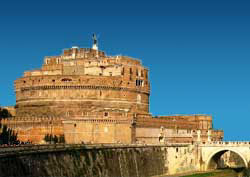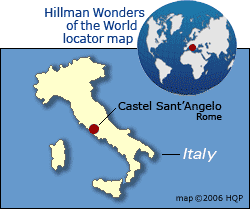Castel Sant'Angelo
 Why
Castel Sant'Angelo
is special
Why
Castel Sant'Angelo
is specialThe cylindrical 19-century-old Castel Sant'Angelo is one of Rome's most striking landmarks and has an intriguing history.
Top 5 attractions of Castel Sant'Angelo
My list
What not to miss:
-
Architecture
The 5-story building has an interesting design, inside and out. For instance, you can walk up a long, spiraling indoor ramp that abuts the circular outer wall.
- Papal apartments
They were luxuriantly decorated during the Renaissance. - Prison cells
High-profile political prisoners were incarcerated (and sometimes tortured and executed) during the Castel Sant'Angelo's papal period. - Military equipment
Ancient tools of war including armor and weaponry are on display. - Rooftop terrace
Enjoy a panoramic view of Rome and the Tiber River. There's a small cafe for food, drink and relaxing.
Right time
Be there in the morning when the venue opens. As a bonus, the low-angled sunlight will enhance your photos.
More Castel Sant'Angelo tips & insights
History in brief
-
2nd century BC
It was originally constructed as a tomb for Emperor Hadrian (117-138 reign) and successors. - Five centuries later
In the 3rd century AD, the Castel Sant'Angelo began its transformation into a military and castle fortress. - 1227
It became a citadel to provide a refuge for popes in the event the Vatican was attacked. - 1901
It was converted into a museum, its present incarnation.
It was built to connect the Vatican and Castel Sant'Angelo. Reasoon: So the pope could quickly flee to the safety of the citadel during threatening times.
Puccini's opera
The final act of Puccini's famous Tosca opera takes place here. After the heroine's lover is executed, she throws herself over the wall to her death.
How Castel Sant'Angelo got its name
It was named for the large statue of the archangel Michael that crowns the building.
Location in Italy



